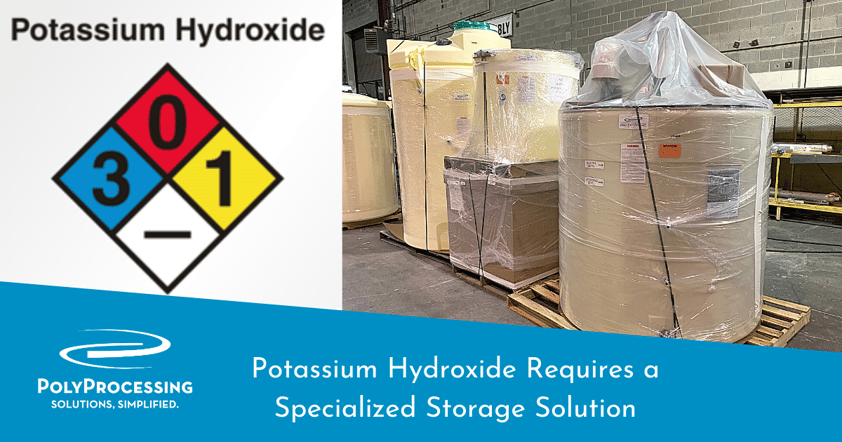Potassium Hydroxide Requires a Specialized Storage Solution
If you’re storing potassium hydroxide, you have a chemical that can’t be taken lightly. Storing and handling potassium hydroxide requires a chemical tank system that will live up to the rigors of a hazardous substance without the possibility of a catastrophic failure in the case of a leak.

Having the proper storage method in place gives peace of mind that you won’t have unexpected incidents or accidents.
Let's take a closer look at potassium hydroxide, how it's used, and how you can properly store it to make certain your employees are safe.
The Challenges of Potassium Hydroxide
Potassium hydroxide, chemically known as KOH, is more commonly known as lye, potash, or caustic potash. The chemical is used in a wide variety of industrial applications, such as water treatment plants — often, to adjust the pH level of acidic water to make it more basic.
Potassium hydroxide is also found in a wide variety of industries, from food production to fertilizers to dyes and pigments and more. It’s also used to produce potassium soaps and detergents and other potassium chemicals. The most common of these is potassium carbonate, which is used primarily in the manufacture of specialty glasses, such as television screens.
When dissolved in water or neutralized with acid, potassium hydroxide releases substantial amounts of heat. This may create a violent, exothermic reaction if it's not done properly, which could ignite combustible materials.
In all forms, caustic potash is highly corrosive and reactive. As a solution, it will react with many metals and reacts readily with organic tissue such as human skin or eyes. Potassium hydroxide is also a severe irritant that can cause serious damage to the upper respiratory tract. It is toxic if swallowed, and corrosive to skin. For this reason, it is critical to ensure that caustic potash is handled and stored properly.
When evaluating your storage options, make sure you consider a secondary containment system. Because of the potential hazards involved, secondary containment is an absolute environmental and safety priority.
Safely Storing Potassium Hydroxide
Potassium hydroxide is very absorbent of moisture in the air, so it must be stored in a cool, dry place. We recommend a tightly closed chemical storage tank located in a well-ventilated area to prevent inhalation problems. Because it’s categorized as a hazardous material, you must take proper precautions for potassium hydroxide storage.
While there are many options for potassium hydroxide storage, a rotationally molded cross-linked polyethylene tank is ideal. This process produces a seamless tank, making it nearly impossible for the chemical to find leaks. This system gives you unbeatable longevity and peace of mind, knowing that the tank is built for potassium hydroxide from the ground up.
SAFE-Tank® System
Because of its hazardous and highly corrosive nature, it is important to have a double wall containment system for caustic potash. Poly Processing’s SAFE-Tank system is a “tank within a tank” that provides greater safety by offering secondary containment that is completely enclosed. The SAFE-Tank provides 110 percent containment within the same footprint as a vertical storage tank, making it easy to store the chemical wherever it’s most efficient and convenient.
IMFO® Tank
If you have containment already in place, consider using the full-drain IMFO Tank. Poly Processing’s Integrally Molded Flanged Outlet (IMFO) Tank uses a flange system that is molded as part of the tank during manufacturing, making the flange a stress-free part of the tank. The flange is created from the same material as the tank — it’s not an insert added during or post-production.
Some companies create tanks out of one substance and insert a metallic flange post-production, for drainage and discharge. This saves money on tooling, but it creates opportunities for leaks to occur.
Advantages of the IMFO Tank include:
- Full tank discharge — Because the flange is at the bottom of the sidewall, below the tank knuckle radius. There’s no need to enter the tank for cleaning.
- Highest amount of static head pressure — The IMFO’s design brings you the highest net positive suction head (NPSH) of any vertical non-coned tank on the market.
- Enhanced long-term performance — Get a fuller useful life out of the tank, since the flange doesn’t compromise the tank’s hoop integrity or structural design.
- Complete flange face protection — The antioxidant OR-1000™ system can protect the discharge components from deterioration, even with aggressive oxidizing chemicals.
- Hassle-free maintenance — Unlike metallic inserts, the flange extends away from the tank wall and the entire flange system is external with easy access.
Potassium hydroxide can be purchased as an NSF 60 approved chemical. It is an NSF/ANSI 61 approved chemical at 50% or less concentration for Poly Processing’s tank systems. The tank system is a 1.65 SPG XLPE tank system, PVC fittings, EPDM gaskets, and 316 SS bolts.
To learn more about how you can ensure proper storage of potassium hydroxide, contact a chemical storage tank expert today.
- June 10, 2024
About Poly Processing
Posts By Topic
Tech Talk Podcast Episodes
Subscribe By Email
Recent Posts
- Installation Tips for Chemical Storage Tanks: Site Preparation and Offloading
- Understanding pH and Chemical Concentration When Choosing a Chemical Tank
- Maximizing Fill Efficiency: Selecting the Optimal Fill Line System
- Chemical Storage Tanks: A Quick Guide for End Users
- Popular Customization Options for Chemical Storage Tanks
Tank Configurator

Find the recommended tank and system components for your chemical storage challenge.
Configure a Tank Package








